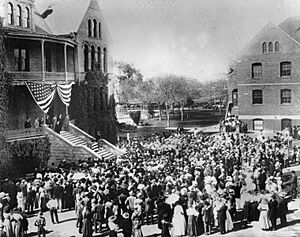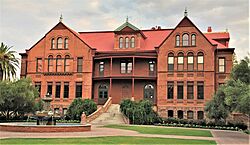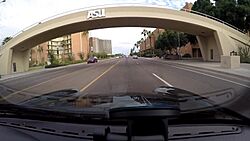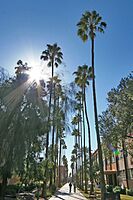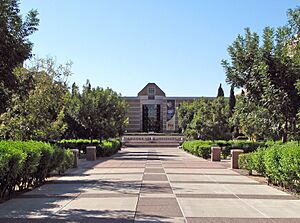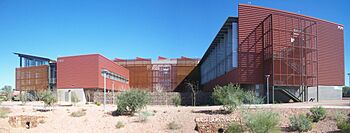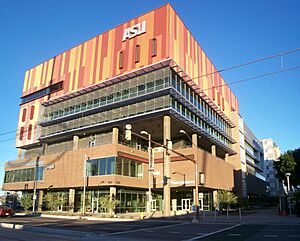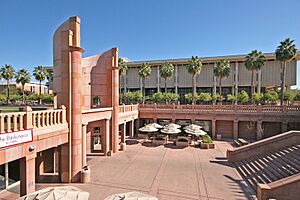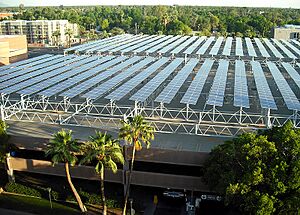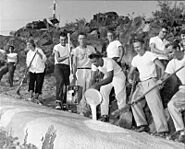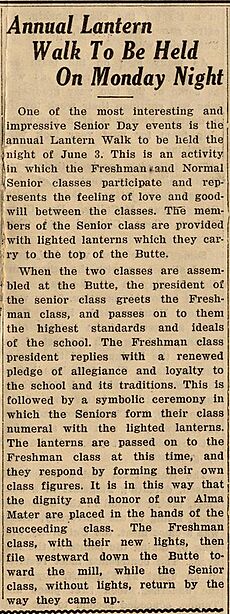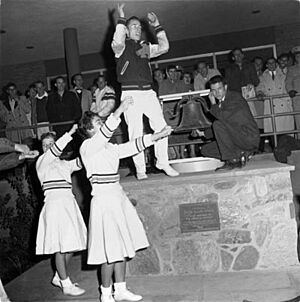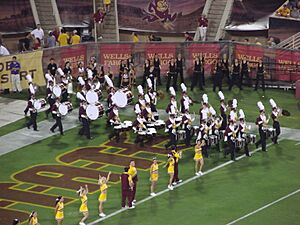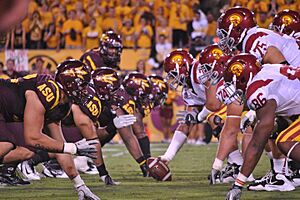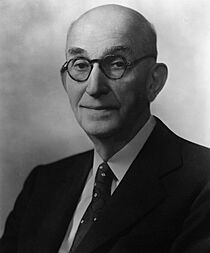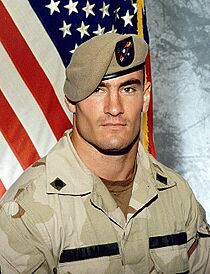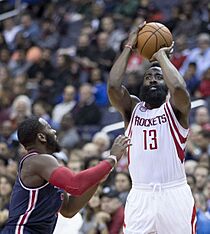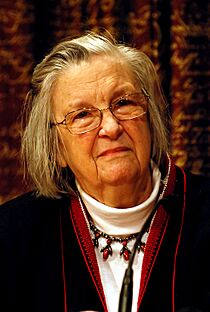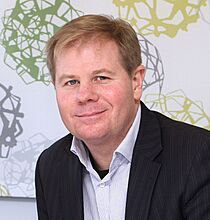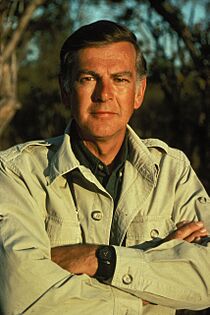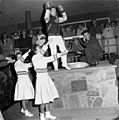Arizona State University facts for kids
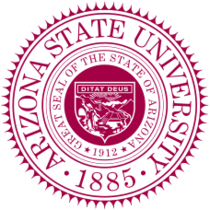 |
|
|
Former names
|
List
Territorial Normal School (1885–1889)
Tempe Normal School of Arizona (1889–1903) Tempe Normal School (1903–1925) Tempe State Teachers College (1925–1929) Arizona State Teachers College (1929–1945) Arizona State College (1945–1958) |
|---|---|
| Motto | On seal: Ditat Deus (Latin) |
|
Motto in English
|
"God enriches" |
| Type | Public research university |
| Established | March 12, 1885 |
|
Parent institution
|
Arizona Board of Regents |
| Accreditation | HLC |
|
Academic affiliation
|
|
| Endowment | $1.59 billion (2024) |
| Budget | $7.9 billion (2025) |
| President | Michael M. Crow |
| Provost | Nancy Gonzales |
|
Academic staff
|
5,400 |
|
Total staff
|
More than 18,500 |
| Students |
|
| Undergraduates | 114,484 |
| Postgraduates | 31,171 |
| Location |
,
,
United States
33°25′15″N 111°56′02″W / 33.4209°N 111.9340°W |
| Campus | Midsize city, 660 acres (2.7 km2) |
| Other campuses and centers | |
| Newspaper | The State Press |
| Colors | Maroon and gold |
| Nickname | Sun Devils |
|
Sporting affiliations
|
|
| Mascot | Sparky the Sun Devil |
 |
|
Arizona State University (often called Arizona State or ASU) is a large public research university in Tempe, Arizona, United States. It was started in 1885 as the Territorial Normal School. At first, it was a school to train teachers. Today, it is one of the biggest public universities in the United States by how many students it has.
ASU is one of three universities managed by the Arizona Board of Regents. It is known for its high level of research activity. More than 183,000 students attend classes at ASU, with over 74,000 learning online. The university has four main campuses and four learning centers across Arizona. Students can choose from over 400 different study programs. There are also more than 450 graduate programs.
The Arizona State Sun Devils are ASU's sports teams. They compete in 26 different sports in NCAA Division I. The Sun Devils have won 165 national championships, including 24 NCAA trophies. Many ASU athletes have also competed in the Olympics, winning 60 medals.
As of February 2024, ASU had over 5,000 teachers and researchers. Many of them are very famous in their fields. This includes Nobel Prize winners, Pulitzer Prize winners, and members of important national academies.
Contents
A Look at ASU's History
How ASU Began: 1885–1929
Arizona State University started on March 12, 1885. It was called the Territorial Normal School at Tempe. Its main goal was to train teachers for the Arizona Territory. The first campus had just one four-room schoolhouse. It was built on land mostly given by Tempe residents George and Martha Wilson. Classes began on February 8, 1886, with 33 students.
Over the years, the school's name changed many times. It was known as Tempe Normal School of Arizona (1889–1903), then Tempe Normal School (1903–1925). In 1925, it became Tempe State Teachers College. It started offering four-year degrees. In 1929, it was renamed Arizona State Teachers College. Finally, in 1958, people in Arizona voted to change its name to Arizona State University.
During the time of President Arthur John Matthews (1900–1930), the school grew a lot. The first dorms in Arizona were built here in 1902. He also had 110 Mexican Fan Palms planted. This created the famous Palm Walk on the Tempe campus.
Growth and Change: 1930–1989
In 1933, Grady Gammage became president. He led the school for almost 28 years. During his time, the university started offering master's and doctoral degrees. The school's name changed to Arizona State College in 1945, and then to Arizona State University in 1958. One of his biggest achievements was building the Grady Gammage Memorial Auditorium. This famous building was designed by the architect Frank Lloyd Wright.
In the 1960s, under President G. Homer Durham, ASU added many new colleges. It also started offering more doctoral degree programs. By 1969, the number of students had more than doubled to 23,000.
Later presidents helped the university grow even more. They focused on computer learning and research. The ASU West Valley campus was opened in 1984. Student numbers kept going up.
Modern ASU: 1990–Present
From 1990 to 2002, Lattie F. Coor was president. During his time, ASU added the Polytechnic campus. The university also focused more on diversity, good teaching, and research. A big fundraising effort brought in over $500 million. This money helped create new programs and scholarships.
In 2002, Michael M. Crow became the 16th president. He had a vision for ASU to become a "New American University". This meant being open to everyone and focusing on research. He also wanted ASU to be "One university in many places". This means all campuses work together as one big school. New campuses were expanded, like the Downtown Phoenix campus.
During President Crow's time, ASU built many new research facilities. This included the Biodesign Institute. The number of researchers also grew, with five Nobel Prize winners joining the faculty. The university's spending on research tripled.
Around 2008, Arizona faced money problems. This led to cuts in ASU's budget. The university had to limit student numbers and close some programs. But by 2011, things improved. ASU continued to expand its campuses. In 2015, the Thunderbird School of Global Management joined ASU. The Sandra Day O'Connor College of Law moved to the Downtown Phoenix campus in 2016.
In September 2024, ASU announced some changes due to state budget cuts. This included closing the Lake Havasu City campus by June 2025.
How ASU is Organized
| College/school | Year founded |
|---|---|
| Barrett, The Honors College | 1988 |
| W. P. Carey School of Business | 1961 |
| Walter Cronkite School of Journalism and Mass Communication | 1941 |
| Edson College of Nursing and Health Innovation | 1957 |
| Ira A. Fulton Schools of Engineering | 1954 |
| Mary Lou Fulton College for Teaching and Learning Innovation | 1954 |
| College of Global Futures | 2020 |
| College of Health Solutions | 2012 |
| Herberger Institute for Design and the Arts | 1964 |
| College of Integrative Sciences and Arts | 2014 |
| The College of Liberal Arts and Sciences | 1954 |
| New College of Interdisciplinary Arts and Sciences | 1984 |
| Sandra Day O'Connor College of Law | 1964 |
| School of Technology for Public Health | 2025 |
| Thunderbird School of Global Management at ASU | 1946 |
| University College | 2011 |
| Watts College of Public Service & Community Solutions | 1979 |
The Arizona Board of Regents (ABOR) is in charge of Arizona State University. They also oversee the University of Arizona and Northern Arizona University. This board helps guide the policies for Arizona's public universities.
ASU has four main campuses in the Phoenix area. These are the Tempe campus, the West Valley campus in Glendale, Arizona, the Downtown Phoenix campus, and the Polytechnic campus in Mesa, Arizona. ASU also offers classes and degrees online. There are also regional learning programs in other Arizona cities.
The Arizona Board of Regents chooses the university's president. The president is like the main leader of the university. They make sure the university follows the board's rules and manages its property. The current president is Michael M. Crow, who started in July 2002.
ASU Campuses and Locations
ASU has four campuses in the Phoenix area. It also has learning centers across Arizona. There are also facilities in Los Angeles, Washington, D.C., and Hawaii. ASU sees itself as "one university in many places." This means all campuses work together as one big school. Each campus has a special focus.
The Tempe campus is the main center for research and graduate studies. The Polytechnic campus focuses on hands-on, technical programs. The West Valley campus is known for its interdisciplinary degrees and liberal arts. The Downtown Phoenix campus focuses on programs like nursing, public policy, and journalism. The Valley Metro Rail connects the Tempe and Downtown Phoenix campuses. Shuttles also help students travel between campuses.
In 2018, ASU had over 23 million square feet of buildings.
Tempe Campus: The Original Home
ASU's Tempe campus is in downtown Tempe, Arizona. It is about 8 miles (13 km) east of Phoenix, Arizona. This campus is urban and covers about 660 acres (2.7 km²). It has wide walking paths and is like an arboretum with many trees. The Tempe campus is the largest, with over 70,000 students in fall 2017.
This is ASU's original campus. Old Main, the oldest building, is still there. The university started here as a teachers college. Many famous places are on this campus. These include Grady Gammage Memorial Auditorium, designed by Frank Lloyd Wright, and Palm Walk with its 111 palm trees. The Tempe campus is also home to Barrett, The Honors College. It has a large collection of public art. The nearby Mill Avenue district has many restaurants and bars for students. All of the university's sports facilities are also on this campus.
-
The Gammage Auditorium was designed by Frank Lloyd Wright
West Valley Campus: A Suburban Gem
The West Valley campus was created in 1984. It is in a suburban area of northwest Phoenix. This campus is about 12 miles (19 km) northwest of Downtown Phoenix. It is a Phoenix Point of Pride. Most of its power comes from solar panels. Over 4,000 students attend this campus. It offers more than 100 degree programs.
Polytechnic Campus: Focus on Technology
The Polytechnic campus started in 1996 as "ASU East". It serves over 4,800 students. It offers more than 130 bachelor's, master's, and doctoral degrees. These programs focus on professional and technical sciences. The campus is a desert arboretum. It has outdoor learning labs and advanced simulators for hands-on learning. This 600-acre (2.4 km²) campus is in southeast Mesa, Arizona. It is about 25 miles (40 km) southeast of the Tempe campus.
Downtown Phoenix Campus: Urban Learning
The Downtown Phoenix campus opened in 2006. It is in the northern part of Downtown Phoenix. This campus has a modern urban design. It mixes new academic buildings with existing city structures. Some old buildings, like a 1930s Post Office, were updated for new uses. Over 11,000 students attend this campus. It is home to colleges for health, nursing, public service, and journalism. The Sandra Day O'Connor College of Law moved here in 2016.
ASU Online: Learning from Anywhere
ASU Online offers over 150 undergraduate and graduate degree programs. Students can complete these programs completely online. The online degrees have the same quality and recognition as degrees earned on campus. ASU Online is based in Scottsdale, Arizona. U.S. News & World Report has ranked ASU Online among the top online bachelor's programs.
Online students learn from the same teachers as on-campus students. They also get the same diploma. ASU Online uses interactive learning tools. In 2015, ASU Online partnered with edX to create the Global Freshman Academy. This program allows anyone to take college courses without needing to apply first.
As of spring 2017, over 25,000 students were enrolled in ASU Online. In 2014, ASU Online and Starbucks started a program. It offers full tuition coverage for Starbucks employees to earn an online degree.
Other ASU Locations
Mayo Clinic School of Medicine Partnership
In 2016, Mayo Clinic and ASU teamed up for health care education and research. Since 2017, Mayo Clinic School of Medicine students in Phoenix can earn a certificate in Health Care Delivery. They can also get a master's degree through ASU.
Washington, D.C. Center
ASU opened the Barrett and O'Connor Washington Center in 2018. This center helps ASU connect with the nation's capital. It hosts academic programs, classes, and internships. It also connects classrooms in Arizona through video calls. The center is located close to the White House.
ASU in California
ASU has a "California Center" in Los Angeles. It is in two buildings, including the former Herald Examiner Building. This center offers undergraduate and graduate programs. In 2022, ASU took over a small college called Columbia College Hollywood and renamed it California College of ASU. In 2023, ASU also partnered with the Fashion Institute of Design & Merchandising.
Academics at ASU
Becoming an ASU Student
| Fall 2021 | Fall 2020 | |
|---|---|---|
| Applicants | 61,603 | 53516 |
| Admits | 54,329 | 47290 |
| % Admitted | 88.2 | 88.3 |
| Enrolled | 14,250 | 12,677 |
| Avg. HS GPA | 3.54 | 3.52 |
As of August 2022, ASU had over 140,000 students, including those learning online. About 79,000 students attended classes in person. Over 61,000 students were enrolled in ASU Online programs.
For the 2022–2023 school year, ASU accepted 88% of new student applications. This means admissions are "selective." The average high school GPA for new students was 3.54.
Barrett, The Honors College is one of the best honors programs in the country. While there are no strict rules to get in, students usually have high grades. For example, in Fall 2017, new students had an average GPA of 3.78.
ASU welcomes students from all over the world. Over 10,000 international students attend ASU. They come from more than 150 different countries. In 2016–2017, ASU was ranked the top public university in the U.S. for hosting international students.
In June 2022, ASU was named a Hispanic-serving institution (HSI). This happened because Hispanic students made up over 25% of the university's undergraduate students in Fall 2021.
What Can You Study at ASU?
| Fall 2021 | Fall 2020 | Fall 2019 | Fall 2018 | Fall 2017 | Fall 2016 | Fall 2015 | Fall 2014 | Fall 2013 | |
|---|---|---|---|---|---|---|---|---|---|
| Undergraduate | 107,425 | 103,609 | 96,726 | 89,888 | 83,544 | 79,442 | 74,139 | 67,498 | 62,082 |
| Graduate | 28,304 | 25,179 | 23,225 | 21,361 | 19,986 | 18,704 | 17,183 | 15,762 | 14,646 |
| Total campus-based enrollment | 77,881 | 74,795 | 75,698 | 73,875 | 72,947 | 72,362 | 71,305 | 69,511 | 66,770 |
| Online | 53,933 | 53,993 | 44,253 | 37,374 | 30,583 | 25,784 | 20,017 | 13,749 | 9,958 |
| Total including online enrollment | 135,729 | 128,788 | 119,951 | 111,249 | 103,530 | 98,146 | 91,322 | 83,260 | 76,728 |
ASU offers over 350 different majors for undergraduate students. It also has more than 100 graduate programs. These programs lead to master's and doctoral degrees. They cover subjects like arts, engineering, journalism, education, business, and law. These programs are spread across ASU's 16 colleges and schools.
ASU also has a 4+1 accelerated program. This allows students to earn their master's degree just one year after their bachelor's. Arizona State University is officially recognized by the Higher Learning Commission. ASU is one of only four universities in the U.S. to offer a certificate in veterans studies.
How ASU Ranks
|
|
|
||||||||||||||||||||||||||||||||||||||||||||||||||||||||||||||||||||||||||||||||||||||||||||||||||||||||||||||||||||||||||||||||||||||||||
In 2025, U.S. News & World Report ranked ASU tied for 121st among all universities in the U.S. It was also tied for 61st among public universities. ASU was ranked 1st for "most innovative schools." This ranking looks at how universities improve their classes, teachers, student life, and technology.
ASU is also highly ranked for its research. It is among the top 100-150 universities in the world by the 2020 Academic Ranking of World Universities. The Wall Street Journal ranked ASU 5th in the nation for producing well-prepared graduates.
ASU's Walter Cronkite School of Journalism and Mass Communication is often named one of the top 10 journalism schools in America.
ASU is a leader in sustainability. The Sierra Club named it one of the top 6 "Cool Schools" in 2017. It also earned an "A−" grade on the 2011 College Sustainability Green Report Card.
Research and Special Institutes
ASU is known for its "Very High Research Activity." In 2020, the university spent $673 million on research. This made it 43rd nationally. ASU is a national space-grant institute. It is also a member of the Universities Research Association. In 2023, ASU joined the Association of American Universities, a group of top research universities.
ASU has received over $999 million in outside funding for research. More than 180 companies have started based on ASU's new ideas. ASU is ranked in the top 10 nationally for U.S. patents given to universities.
The university has created many special institutes for research. These include the Institute of Human Origins and the Biodesign Institute. The Biodesign Institute does research on health care and diseases. It has attracted over $760 million in funding. It has also led to 35 new companies.
During the COVID-19 pandemic, Biodesign created a quick, saliva-based test. They partnered with Arizona's health department to make it available to the public. The institute also works on sustainability research. This includes turning CO2 into clean biofuels.
ASU is also involved with NASA in space exploration. ASU built a large science building called ISTB 4. It cost $110 million. This building has labs for the School of Earth and Space Exploration. One project there is the OSIRIS-REx Thermal Emission Spectrometer (OTES). This is the first major science tool completely designed and built at ASU for a NASA mission.
The Army Research Laboratory gave ASU's Flexible Display Center (FDC) a $50 million grant in 2009. In 2012, researchers at the center made the world's largest flexible full-color organic light-emitting diode (OLED). This technology creates bright colors and uses less power.
Luminosity Lab: Student-Led Innovation
The Luminosity Lab is a special group at ASU. It is a student-led research and development team. It was started in 2016 by Dr. Mark Naufel. Students from many different subjects work together here.
ASU Libraries
ASU has nine libraries across its campuses. These include Hayden Library, Noble Library, and the Downtown Phoenix campus library.
As of 2013, ASU's libraries had 4.5 million books and other items. The ASU library system is the 34th largest research library in the U.S. and Canada.
Hayden Library is the biggest library at ASU. It opened in 1966. It has an underground entrance and a landmark called the "Beacon of Knowledge." The library lights up this beacon at night. Hayden Library is currently being updated and renovated.
Sustainability Efforts
As of March 2014, ASU was the top university in the U.S. for producing solar energy. Today, the university creates over 24 megawatts of electricity from solar panels on its campuses. In January 2017, another large solar installation was added. This brought ASU's total solar power to 50 megawatts.
ASU's School of Sustainability was the first in the U.S. to offer degrees in sustainability. This school is part of the Wrigley Global Institute of Sustainability. It started in 2007. The school offers majors, minors, and certificates in sustainability.
ASU is a leader in making its operations sustainable. The university has set many goals. One goal is to recycle and compost a lot of its waste. Another goal is to reduce water use by 50%. ASU also aims to be the first large research university to have zero greenhouse gas from its operations.
ASU Traditions
Maroon and Gold: ASU's Colors
Gold is the oldest color linked to Arizona State University. It dates back to 1896. Maroon and white were added in 1898. Gold stands for ASU's "golden promise" of a good education. It also represents Arizona's sunshine. Maroon means sacrifice and bravery. White shows balance. On game days, the student section, called The Inferno, wears gold.
Sparky the Sun Devil: The Mascot
Sparky the Sun Devil is the mascot of Arizona State University. Students voted for his name on November 8, 1946. Sparky often travels with the sports teams. He is at every football bowl game. Sparky is seen at every home game in Sun Devil Stadium. He does pushups after every touchdown the Sun Devils score. He is helped by Sparky's Crew, who are male yell leaders. The female members are the Spirit Squad. They compete in dance competitions.
"A" Mountain: A Campus Landmark
A large letter has been on the side of Tempe Butte since 1918. At first, it was a "T" and then an "N". Since 1938, it has been an "A". The "A" is made of strong concrete. There are many traditions around "A" Mountain. One is "Echo from the Buttes." New students paint the "A" white during orientation. It is then repainted gold before the first football game.
Lantern Walk and Homecoming
The Lantern Walk is one of ASU's oldest traditions, dating back to 1917. It is a special event to remember the history of ASU. Students, alumni, teachers, and friends can all join. In the past, seniors carried lanterns up "A" Mountain, followed by freshmen. Today, participants walk through campus and up "A" Mountain to "light up" Tempe. The night ends with fireworks. The Lantern Walk is held the week before Homecoming. Homecoming is a tradition that started in 1924 and happens in the fall with a football game.
Victory Bell: Celebrating Wins
In 2012, Arizona State University brought back the tradition of ringing a bell after each football team win. ROTC students move the bell to different events. The first Victory Bell was used in the 1930s. That old bell is now a landmark near Sun Devil Stadium.
Sun Devil Marching Band and Devil Walk
The Arizona State University Sun Devil Marching Band started in 1915. It is known as the "Pride of the Southwest." It was one of the first marching bands in the Pac-12 to win the prestigious Sudler Trophy in 1991. The band performs at every football game. They also appear at other sports events.
The Devil Walk is a tradition where the football team meets fans before games. It starts about two hours before the game. This allows players to connect with the fans. The walk ends as the team goes into Sun Devil Stadium. The most famous songs played by the band are "Alma Mater" and the fight songs "Maroon and Gold" and "Al Davis Fight Song."
Curtain of Distraction: Fun at Basketball Games
The Curtain of Distraction is a fun tradition at men's and women's basketball games. It started in 2013 to get more fans to the games. In the second half, a curtain opens when an opponent is shooting a free throw. Students pop out to try to distract them. They do funny skits, like someone dressed as Elvis. In 2016, Olympic swimmer Michael Phelps even came out of the curtain in a Speedo.
Student Life at ASU
| Race and ethnicity | Total | ||
|---|---|---|---|
| White | 43% |
|
|
| Hispanic | 23% |
|
|
| International student | 9% |
|
|
| Asian | 7% |
|
|
| Black | 6% |
|
|
| Unknown | 6% |
|
|
| Two or more races | 5% |
|
|
| American Indian and Alaska Native | 1% |
|
|
| Economic diversity | |||
| Low-income | 31% |
|
|
| Affluent | 69% |
|
|
Student Activities
Arizona State University has many activities outside of classes. Students can join clubs, sororities, fraternities, and do community service. They can also get involved in leadership and student government.
Devils' Advocates is the oldest student group. It started in 1966. These students give tours of the campus to visitors.
Changemaker Central is a student-run center. It helps students get involved in solving social problems. It offers creative spaces for students to work together. They also have programs like the Changemaker Challenge. Students can win money to start their own projects that help the community.
The Greek community at ASU is also very active. It helps students connect and find social activities. ASU is home to one of the first and fastest-growing gay fraternities, Sigma Phi Beta. This shows ASU's commitment to supporting diversity.
Student News and Radio
The State Press is ASU's student-run newspaper. It covers news and events on all four campuses. Students are in charge of its content.
The Downtown Devil is a student news website for the Downtown Phoenix Campus. Students from the Walter Cronkite School of Journalism and Mass Communication create it.
Blaze Radio is ASU's student-run radio station. It is funded by the Cronkite School of Journalism. It broadcasts online 24 hours a day. It features student-hosted news, music, and sports shows.
Student Government
Associated Students of Arizona State University (ASASU) is the student government. It includes the Undergraduate Student Government (USG) and the Graduate & Professional Student Association (GPSA). Each ASU campus has its own USG. Students vote for the members and leaders of ASASU every year.
The Residence Hall Association (RHA) is the student government for students living on campus. Each campus has its own RHA. Their goal is to make life better for students in dorms. They do this by listening to student concerns and organizing events.
ASU Athletics: The Sun Devils
Arizona State University's sports teams are called the Sun Devils. This is also a nickname for students and alumni. They compete in the Big 12 Conference in 20 different sports. ASU has been very successful in sports like baseball, golf, swimming, and wrestling.
ASU has won 24 national team championships. These include 5 in baseball, 8 in women's golf, and 2 in softball.

In April 2015, Bobby Hurley became the men's basketball coach. In 2015, Bob Bowman was hired as the head swim coach. He famously trained Olympic swimmer Michael Phelps.
Since Fall 2015, ASU students can get a free ticket to all ASU athletic events. They just need a valid student ID and to reserve a ticket online.
Famous ASU Alumni
Arizona State University has over 600,000 alumni around the world. The ASU Alumni Association is located in Old Main on the Tempe campus.
Leaders in Politics
Many important people in politics have attended ASU. This includes U.S. Senator Carl Hayden. Barbara Barrett served as the U.S. Ambassador to Finland. She also served as the Secretary of the U.S. Air Force. She earned three degrees from ASU.
Other famous alumni include former U.S. Representatives like Ed Pastor. Arizona governors Doug Ducey and Jane Dee Hull also went to ASU. Peterson Zah, the first president of the Navajo Nation, is an ASU alumnus.
Business Leaders
Ira A. Fulton, who founded Fulton Homes, is an ASU alumnus. Kate Spade, the co-founder of Kate Spade New York, also attended ASU. Alumnus Kevin Warren is a top executive for the Minnesota Vikings football team.
Sports Stars
Many world-famous athletes have gone to ASU. This includes Pat Tillman, who left his National Football League career to join the U.S. Army after the September 11 attacks. World Golf Hall of Fame member Phil Mickelson is an alumnus. So are Baseball Hall of Fame member Reggie Jackson and NBA All-Star James Harden.
Other notable athletes include baseball players Ian Kinsler and Dustin Pedroia. Football players Jake Plummer and Danny White also attended ASU. Golfer Jon Rahm, who won the 2021 U.S. Open, is an alumnus. Olympic gold medalist swimmers Melissa Belote and Jan Henne also went to ASU.
Actors, Artists, and Writers
Famous people in entertainment who attended ASU include: Jimmy Kimmel Live! host Jimmy Kimmel. Steve Allen, the first host of The Tonight Show, also went to ASU. Academy Award-nominated actor Nick Nolte is an alumnus. So are singer Linda Ronstadt and actor David Spade. Wonder Woman actress Lynda Carter also attended ASU.
Writers and novelists include Allison DuBois, whose work inspired the TV show Medium. Best-selling author Temple Grandin is also an alumna.
Journalists and commentators include former Monday Night Football announcer Al Michaels. Radio host Michael Reagan, son of President Ronald Reagan, also briefly attended.
ASU Faculty
ASU's teachers and researchers have included many famous people. These include former CNN host Aaron Brown and physicist Paul Davies. Pulitzer Prize winner Bert Hölldobler is also a faculty member. Donald Johanson, who discovered the ancient human fossil Lucy (Australopithecus), is a professor at ASU.
Nobel Prize winners Leland Hartwell and Edward C. Prescott have been faculty members. Elinor Ostrom, ASU's third Nobel laureate, passed away in 2012.
As of 2020, ASU faculty achievements include:
- 5 Nobel laureates
- 7 Pulitzer Prize winners
- 24 National Academy members
- 5 MacArthur Fellows
- 250 Fulbright American Scholars
Presidential Visits to ASU
Arizona State University has been visited by nine United States presidents. President Theodore Roosevelt was the first to visit. He spoke at Old Main on March 20, 1911. President Lyndon B. Johnson spoke at ASU's Grady Gammage Memorial Auditorium in 1972. Future president Gerald R. Ford debated there in 1968. He returned as a former president in 1984.
President Jimmy Carter visited ASU's Walter Cronkite School of Journalism in 2015. Future president Ronald Reagan gave a speech at ASU in 1957. He returned as a former president in 1989. President George H. W. Bush gave a lecture at ASU in 1998.
President Bill Clinton was the first sitting president to visit ASU. He spoke in 1996. He returned in 2006 and 2014. President George W. Bush was the second sitting president to visit. He debated at ASU in 2004. President Barack Obama visited ASU as sitting president in 2009. He gave the commencement speech. President Richard Nixon did not visit as president, but he acknowledged the ASU Band during an event in Phoenix in 1970.
Images for kids
-
ASU's Gammage Auditorium, designed by Frank Lloyd Wright
-
James Harden, ASU Basketball
See also
 In Spanish: Universidad Estatal de Arizona para niños
In Spanish: Universidad Estatal de Arizona para niños


